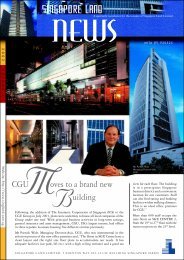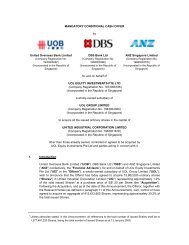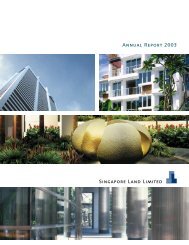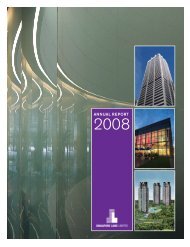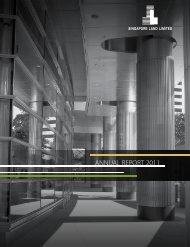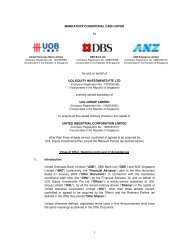Annual Report 2012 - singapore land limited
Annual Report 2012 - singapore land limited
Annual Report 2012 - singapore land limited
Create successful ePaper yourself
Turn your PDF publications into a flip-book with our unique Google optimized e-Paper software.
86<br />
Singapore Land Limited - <strong>Annual</strong> <strong>Report</strong> <strong>2012</strong><br />
NOTES TO THE FINANCIAL STATEMENTS<br />
For the fi nancial year ended 31 December <strong>2012</strong><br />
28. FINANCIAL RISK MANAGEMENT (continued)<br />
(a)<br />
Market risk (continued)<br />
(ii)<br />
Cash fl ow and fair value interest rate risks<br />
Cash fl ow interest rate risk is the risk that the future cash fl ows of a fi nancial instrument will fl uctuate<br />
because of changes in market interest rates. Fair value interest rate risk is the risk that the fair value of a<br />
fi nancial instrument will fl uctuate due to changes in market interest rates. As the Group has no signifi cant<br />
interest-bearing assets, the Group’s income and operating cash fl ows are substantially independent of<br />
changes in market interest rates.<br />
The Group’s interest rate risks mainly arise from borrowings. Borrowings at variable rates expose<br />
the Group to cash fl ow interest rate risk. Borrowings obtained at fi xed rates expose the Group to fair<br />
value interest rate risk. The Group monitors the interest rates on borrowings closely to ensure that the<br />
borrowings are maintained at favourable rates.<br />
If the interest rates increase/decrease by 25 basis points (2011: 25 basis points) with all other variables<br />
remaining constant, the profi t after tax for the Group and the Company will be lower/higher by $291,000<br />
(2011: $526,000) and $281,000 (2011: $374,000) respectively as a result of higher/lower interest<br />
expense on these borrowings.<br />
(b) Credit risk<br />
Credit risk refers to the risk that a counterparty will default on its contractual obligations resulting in fi nancial<br />
loss to the Group. For trade receivables, the Group adopts the policy of dealing only with customers of<br />
appropriate credit standing and history, and obtaining suffi cient security where appropriate to mitigate credit<br />
risk. For the property investment segment, generally advance deposits of at least 3 months rental (or equivalent<br />
amount in bankers’ guarantee) are obtained for all tenancies. For the property trading segment, progress<br />
billings from customers are followed up, and appropriate action taken promptly in instances of non-payment<br />
or delay in payment. For other fi nancial assets, the Group adopts the policy of dealing only with high credit<br />
quality counterparties.<br />
Other than amounts due from subsidiary and associated companies, and joint ventures, concentration of<br />
credit risk relating to trade receivables is <strong>limited</strong> due to the Group’s many varied customers.<br />
As the Group and the Company do not hold any collateral, the maximum exposure to credit risk for each<br />
class of fi nancial instruments is the carrying amount of that class of fi nancial instruments presented on the<br />
statement of fi nancial position.<br />
The Group’s and the Company’s major classes of fi nancial assets are bank deposits, trade receivables and<br />
other non-current receivables.





